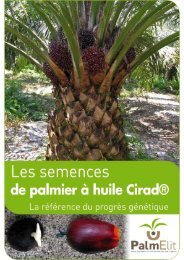You also want an ePaper? Increase the reach of your titles
YUMPU automatically turns print PDFs into web optimized ePapers that Google loves.
<strong>Camels</strong><br />
Producers of the desert<br />
The large camels (dromedaries and Bactrian camels)<br />
are probably the domestic species with the<br />
widest range of different functions. Not only do<br />
they provide milk, meat and wool (high quality in the<br />
case of Bactrian camels), they also provide energy to<br />
transport people and goods and for agricultural activities<br />
and are used for leisure purposes, be it racing or rides<br />
at tourist sites.<br />
Mechanical milking of a dairy camel in Saudi<br />
Arabia. © B. Faye/CIRAD<br />
Milk: while consumption is marginal (less<br />
than 1% of the milk consumed worldwide),<br />
camel’s milk plays an original role. It is<br />
reputed to have a whole range of therapeutic<br />
properties, associated to varying degrees with<br />
its composition: it is hypoallergenic (it does not<br />
contain beta-lactoglobulin, which causes allergies);<br />
it has a hypoglycemiant effect of use to diabetics; it is<br />
exceptionally rich in vitamin C and contains highly<br />
bioactive lactoferrin, hence acts against harmful bacteria; its lactose is easier to digest; and<br />
it is rich in unsaturated fatty acids and minerals.<br />
Local consumption is booming, with demand outstripping supply, as urban consumers<br />
appreciate its beneficial effects on health. Production systems are becoming increasingly<br />
modern, from promotion of traditional extensive systems to intensive industrial production.<br />
Cheese production remains difficult, although recent technological advances have improved<br />
its potential.<br />
Meat: camel meat production is low due to the<br />
length of the animal’s reproductive cycle, but the<br />
quality of the meat from animals less than four<br />
years old is similar to that of beef, with various<br />
dietetic advantages (less cholesterol). The supply<br />
chain is largely regionalized, with significant trade<br />
flows from Africa to the Near East. Processing is<br />
restricted to importing countries (Egypt, Libya, Gulf<br />
States, Saudi Arabia), but is a commercial asset for<br />
African farmers.<br />
Original, popular products<br />
Camel herdsman in the El-Obeid<br />
region, Sudan. © B. Faye/CIRAD<br />
Contact<br />
Bernard Faye<br />
CIRAD, UMR SELMET<br />
Mediterranean and<br />
Tropical Livestock Systems<br />
Camel and Range<br />
Research Center<br />
PB 322<br />
Al-Jouf-Sakaka<br />
Saudi Arabia<br />
bernard.faye@cirad.fr<br />
Camel butcher’s shop in Maroco.<br />
© P. Dugué/CIRAD
The research that is under way<br />
(Sudan, Oman, Saudi Arabia,<br />
Tunisia) is aimed at responding<br />
better to consumer demand and<br />
market opportunities. There are<br />
highly efficient pastoral fattening<br />
systems, and enclosed fattening<br />
installations are being tested (for<br />
instance in Tunisia) with a view to<br />
producing quality meat.<br />
Wool: camel’s wool is traded on<br />
the international market. Although<br />
the market primarily concerns wool from alpacas and other small Andean<br />
camelids, Bactrian camel’s wool is also used industrially, for instance in<br />
Mongolia, where mills offer luxury goods distributors Bactrian “cashmere”.<br />
Dromedary’s wool is less popular, but is often sufficient for local demand<br />
and is sold to tourists.<br />
Transport, draught and agriculture<br />
Despite the end of trans-Saharan camel trains, dromedaries are still used to carry nonperishable<br />
goods in zones that are inaccessible to vehicles (there are still salt caravans)<br />
and camp equipment during large-scale transhumance (in Chad, they can travel several<br />
hundred kilometres). They are used to draw water during the dry season or to drive norias.<br />
Draught is practised extensively in India, in Rajasthan, and is also observed in Sahelian<br />
countries, where dromedaries tend to be used more than donkeys, because of their strength.<br />
<strong>Camels</strong> are also used to transport cereal crops to farmers’ houses (chele in Chad). These<br />
complementarities are a guarantee of social harmony in countries where conflict between<br />
crop and animal farmers may occur.<br />
The main issues<br />
For research, the development of large<br />
camelids encompasses four major<br />
issues:<br />
• the future of nomadic pastoral<br />
societies in the face of climate change<br />
and economic globalization, which<br />
means making camel products a<br />
market commodity;<br />
• food security in countries largely<br />
made up of desert, which want to<br />
maintain a rural population in the<br />
most marginal zones while using<br />
some areas solely for livestock farming<br />
Camel market in Sudan. © B. Faye/ CIRAD<br />
(excluding oases);<br />
• global warming, which has resulted in the rapid extension of the area in which dromedaries<br />
are reared, particularly in Africa, in countries that overlooked the species until less than 20<br />
years ago (Nigeria, Cameroon, Central African Republic, Uganda, Tanzania); camel rearing<br />
has spread right up to the fringes of agricultural areas through a switch in species (from cattle<br />
to camelids), including among pastoral communities previously centred on cattle farming<br />
(Fula, Maasai);<br />
• emerging diseases, a phenomenon linked to the above trends, given that the spread of<br />
camel rearing towards the less arid zones of Sahelo-Sudanian Africa brings the animals into<br />
contact with a potentially pathogenic environment that differs from the entirely desert zones<br />
used previously.<br />
© CIRAD, February 2012<br />
Milking a Bactrian camel in the steppe,<br />
Kazakhstan. © B. Faye/CIRAD<br />
Mongolian camel reared for its wool.<br />
© B. Faye/CIRAD<br />
Partners<br />
• Camel and Range<br />
Research Center, Al-Jouf,<br />
FAO, Saudi Arabia<br />
• DRC, Desert Research<br />
Center, Egypt<br />
• IAV, Institut agronomique<br />
et vétérinaire Hassan II,<br />
Morocco<br />
• IRA, Institut des régions<br />
arides, Tunisia<br />
• Al-Farabi University,<br />
Almaty, Kazakhstan<br />
• University of the United<br />
Arab Emirates, College of<br />
Food and Agriculture<br />
• Universities of Khartoum<br />
and El-Obeid, Sudan<br />
• University of La Molina<br />
and Mountain Institute,<br />
Peru<br />
• University of Ouargla,<br />
Algeria<br />
www.cirad.fr


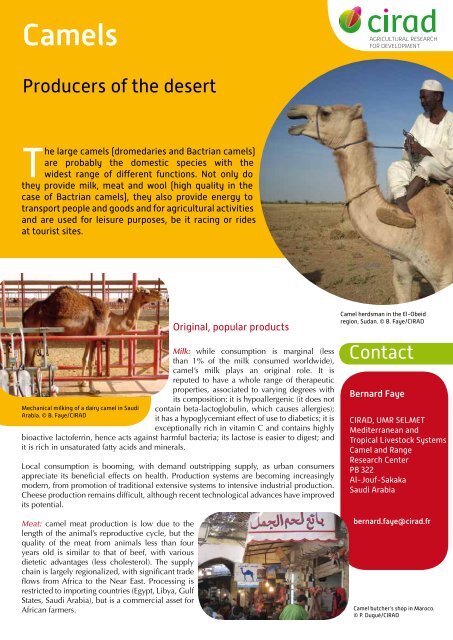
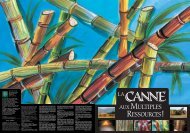

![Version française [pdf, 376,65 ko] - Cirad](https://img.yumpu.com/26838166/1/184x260/version-franaaise-pdf-37665-ko-cirad.jpg?quality=85)
![VIP N°4 [FR] - Cirad](https://img.yumpu.com/26838163/1/184x260/vip-na4-fr-cirad.jpg?quality=85)
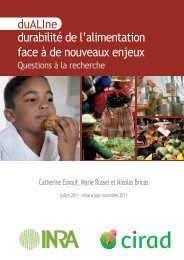
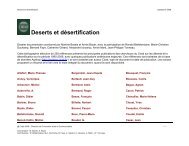
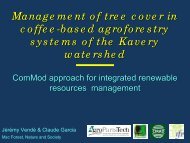
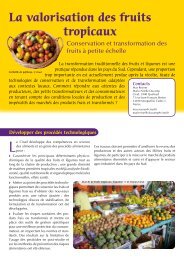

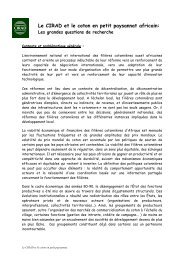
![VIP N.4 [ESP]--> PDF - Cirad](https://img.yumpu.com/26838123/1/184x260/vip-n4-esp-pdf-cirad.jpg?quality=85)
![Version française [pdf, 493,34 ko] - Cirad](https://img.yumpu.com/26838117/1/184x260/version-franaaise-pdf-49334-ko-cirad.jpg?quality=85)
![Version française [pdf, 180,31 ko] - Cirad](https://img.yumpu.com/26838111/1/184x260/version-franaaise-pdf-18031-ko-cirad.jpg?quality=85)

